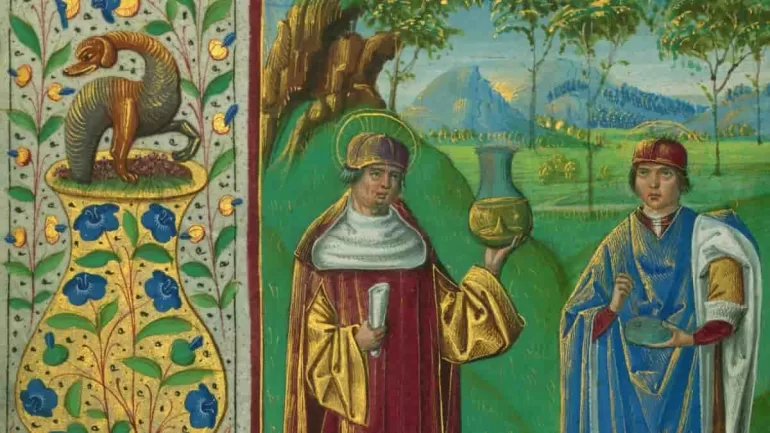ART & DESIGN
Saints Cosmas and Damian, Patron Saints of Doctors (detail), Almugavar Hours, Spain, ca. 1500. It shows an intersection of art, faith, and healing in Medieval healing practices. Bequest of Henry Walters, 1931. Image: The Walters Art Museum
Explore the secrets of medieval healing practices and learn how art, faith, and herbal remedies shaped the understanding of health in history
BY KAZEEM ADELEKE, ARTCENTRON
BALTIMORE, MD--Throughout history, health, wellness, and healing have occupied a central place in human existence. In medieval Europe, the understanding of health transcended mere physical well-being; it encompassed a profound connection between the body and soul. This holistic perspective not only defined how individuals approached healing but also shaped their societal structures, artistic expressions, and spiritual beliefs. The intertwining of these elements is central in the exhibition, Healing the Body, Healing the Soul: Methods of Therapy in Medieval Europe at the Walters Art Museum.
The medieval mindset viewed the body and soul as interconnected entities, necessitating a harmonious balance for optimal health. This approach influenced various therapeutic practices of the time, which the exhibition categorized into three primary areas: physical healing, spiritual healing, and the interlinked nature of these two realms.
1. Physical Healing: Insights into Medieval Medicine
The first section of the exhibition offers an in-depth look at physical healing practices prevalent during the medieval period. There was a reliance on ancient medical texts, particularly those of Hippocrates and Galen during the era. Their teachings emphasized the balance of the four bodily humors: blood, phlegm, yellow bile, and black bile. This balance was crucial to achieving and maintaining health.
Herbal remedies played a significant role in medieval medical practices. There was meticulous harvesting and preparation of local plants, serving as natural treatments for various ailments. Additionally, the practice of bloodletting was common, reflecting the belief that removing excess blood could restore harmony within the body. Barber-surgeons often performed these interventions, functioning as both healthcare providers and barbers. Their work highlights the blend of medical practice and daily life during this period.
2. Spiritual Healing: The Power of Faith and Divine Intervention
In stark contrast to physical healing, the second section of the exhibition delves into spiritual healing. During the medieval era, the belief in divine intervention was paramount. Individuals frequently undertook pilgrimages to sacred sites, seeking miraculous healing from saints revered for their powers. These journeys were not merely physical; they were deeply spiritual experiences, reflecting the intertwining of faith and healing.
Art and literature from this period underscore the significance of prayer, meditation, and other spiritual exercises as essential components of wellness. Manuscripts, paintings, and sculptures often depicted
scenes of healing infused with religious themes. This reinforced the idea that spiritual well-being was essential for physical recovery.
3. Interlinked Health: A Holistic Perspective
The third section of the exhibition focuses on the interlinked nature of physical and spiritual health. This holistic approach suggests that neglecting one aspect could adversely affect the other. Medieval artworks frequently showcase this relationship by illustrating healing scenes that address physical ailments
alongside spiritual fortification.
For instance, certain art pieces demonstrate the belief that healing could come through a combination of herbal remedies and prayer. This encapsulates the holistic view that health is a multifaceted pursuit. Interestingly, this concept remains relevant today. Modern medicine increasingly recognizes the importance of mental and spiritual health in the healing process.
Art and Literature: The Cultural Reflection of Healing

Art in Medieval Healing Practices
Art played an important role in shaping medieval attitudes towards health and healing. The exhibition features illuminated manuscripts, paintings, and sculptures that capture themes of healing, faith, and miracles. One highlight features a Book of Hours created for a member of the Almugavar family, dating from 1510–1520. This exquisite manuscript features lavish miniatures and intricate designs, reflecting both the owner’s social status and commitment to spiritual health.
The Almugavar coat of arms, prominently featured throughout the manuscript, symbolizes personal significance and familial legacy. The twenty-six vibrant polychrome miniatures vividly depict various feast days and significant events in Barcelona. It showcases the fusion of local artistic traditions with broader European influences.
Contemporary Perspectives: Bridging the Past and Present
The exhibition does not merely dwell on the past; it also juxtaposes historical practices with contemporary perspectives. One compelling inclusion is the work of blind artist Pete Eckert. His Bone Light series explores the relationship between light and disability through innovative photography. Eckert’s experiences provide a modern lens through which we can examine how disability intersects with notions of health and healing.
His work, characterized by the phantom light emanating from his bones, draws parallels between the contemporary understanding of the body and spirit and historical beliefs. This inclusion emphasizes the ongoing dialogue surrounding health, wellness, and the complexities of the human experience.
The Enduring Legacy of Medieval Healing Practices
The exploration of health, wellness, and healing in medieval Europe unveils a rich tapestry of beliefs and practices that resonate profoundly today. The Healing the Body, Healing the Soul exhibition offers invaluable insights into how art and literature shaped medieval understandings of wellness, illustrating the intricate relationship between body and soul.
A deep reflection of these medieval healing practices shows their enduring legacy in contemporary discussions about health and healing. This exhibition is a unique opportunity to excavate the past and appreciate the complexities of health and wellness through the lens of art and culture. For those interested in deepening their understanding of how these themes have evolved, visiting the exhibition will provide a comprehensive look at the past’s influence on modern health perspectives.
Healing the Body, Healing the Soul: Methods of Therapy in Medieval Europe is on display at the Walters Art Museum through December 15, 2024.
